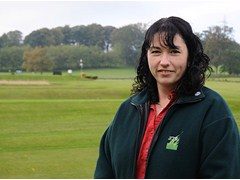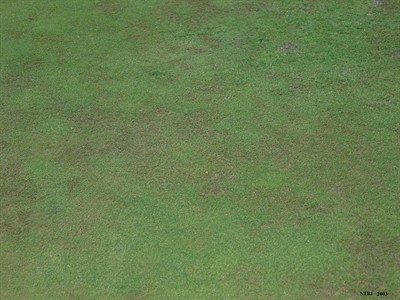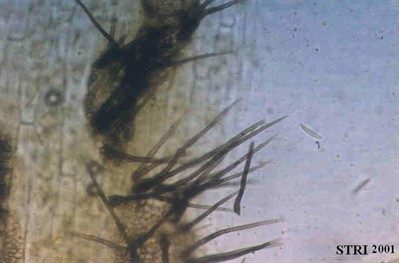
Anthracnose foliar blight is rife during typical British summer conditions of warm weather with intermittent rain, writes STRI's lead turf pathologist, Dr Ruth Mann.
The foliar blight is often difficult to identify as it appears just like drought symptoms (Plate 1). Unfortunately, irrigation to help relieve the 'drought' often results in further disease development and more severe symptoms. Foliar blight can be confirmed by the presence of acervuli and hair-like structures called setae (Plate 2).

Plate 1: Anthracnose foliar blight

Plate 2: Acervuli with hair-like setae
Anthracnose is most severe on Annual meadow-grass (Poa annua) but it has also been noted on Bentgrass and Fescue grass species. High risk situations occur with Annual meadow-grass dominant swards and turfgrass under stress.
Many types of stress predispose turf to anthracnose, such as drought, insect or nematode feeding, compaction and excessively low cutting heights. However, the most common stress associated with anthracnose is low fertility. Where this occurs, the grass plant can struggle to grow optimally, allowing Colletotrichum cereale (the pathogen that causes anthracnose) to take hold in senescent areas of the plant and infection begins.
Managing turfgrass to reduce the ingress of Annual meadow-grass will make the sward less susceptible to attack. Therefore, attention to fertilisation, irrigation and surface conversion techniques to promote Bentgrass and/or Fescue should form part of the long-term control measures.
Any stress factors also need to be alleviated. Nitrogen fertility is often low in areas affected by anthracnose, therefore an application of nitrogen may reduce the stress and suppress the symptoms. Drought conditions should be avoided on turf dominant in Annual meadow-grass to ensure turf is not stressed. Excessively low cutting heights should also be avoided, as this adds to the stress on the grass plants.
Propiconazole (Banner Maxx) and fludioxonil (Medallion TL) have activity on anthracnose foliar blight. These fungicides are best applied preventatively, as once an Annual meadow-grass plant is infected, it cannot be cured. Once symptoms become apparent, however, treatment with propiconazole or fludioxonil will still help to protect neighbouring plants that have not yet been affected.
Research at STRI has shown that combining fungicides with nitrogen applications can arrest the anthracnose development, promote turf recovery and ensure the grass plant is left less susceptible to further infection. An application of propiconazole when symptoms of infection were apparent significantly reduced the area affected by foliar blight compared to untreated plots. Furthermore, supplementing the fungicide with a Sierraform GT fertiliser programme to total 118 kg N ha-1 over the course of the growing season greatly improved the turf quality, recovery potential and further growth, leading to prolonged anthracnose management.
